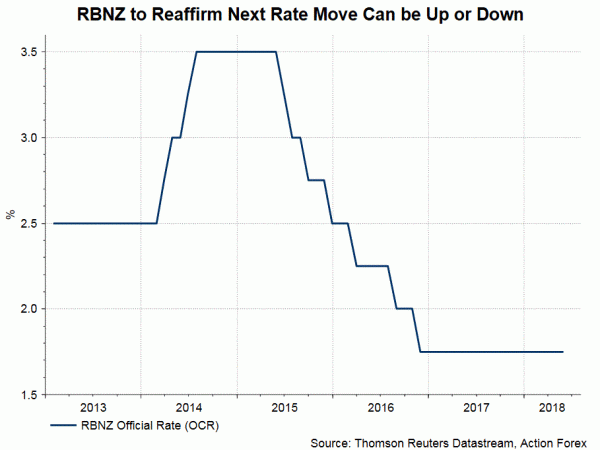At the August 9 meeting (this Thursday), we expect RBNZ to leave the OCR unchanged at 1.75% and deliver a neutral to slightly dovish policy statement. Since the June meeting, data showed that economic growth moderated while inflation picked up. In the job market, the unemployment rate climbed higher to 4.5% in 2Q18.
We expect policymakers to look through the improvement in inflation data and maintain accommodative monetary policy at least until late 2019. The central bank will likely reiterate that the next move in the OCR could be “up or down”. On the updated economic forecasts, we expect the central bank to downgrade the GDP growth projection in light of recent slowdown.
RBNZ to lower GDP growth forecasts
GDP growth slowed to +0.5% q/q in 1Q18 from +0.6% in the prior quarter. The annual growth, at +2.7%, also marked the weakest in almost 4 years. Meanwhile, business confidence weakened further.
According to NZIER’s Quarterly Survey of Business Opinion (QSBO), a net 19% of businesses expect deterioration in economic conditions in 2Q18, compared with 10% in the previous quarter. As suggested in the accompanying statement, firms’ expectations of future demand eased, “with fewer businesses expecting improved demand over the next quarter”. This signals “softer economic growth in the second half of 2018”.
As such, we expect RBNZ to revise lower its GDP growth forecasts. In May, the central bank projected GDP growth to reach +3% this year, before peaking at +3.3% in 2019, and then slowing to + 3.1% in 2020.
RBNZ to gauge inflation data cautiously despite uptick
On inflation, headline CPI rose +0.4% q/q, and 1.5% y/y, in 2Q18, accelerated from +0.5% q/q and 1.1% y/y from the prior quarter. The strong growth was driven by house rents and the rise in global fuel prices. Notably, the sectoral factor model CPI rose to a 7-year high of +1.7% y/y for the quarter. Meanwhile, there have been continuous improvements since last year from +1.4% in 3Q17 to +1.5% in 4Q17 to +1.6% in 1Q18.
The sectoral factor model CPI, one of RBNZ’s preferred core inflation gauge, estimates the common component of inflation in the CPI basket, the tradable basket, and the non-tradable basket, based upon separate factors for the tradable and non-tradable sectors. The data excludes GST. While the second quarter data suggests that inflation is moving towards RBNZ’s +2% target, the board members would likely prefer to gauge the data more cautiously.
Job market resilient despite slight rise in unemployment rate
Although unemployment rate rose marginally to 4.5% in 2Q18, from the 9-year low of 4.4% in the prior quarter, the job market has remained resilient. First, the rise in the unemployment rate was a result of the increase in the participation rate to 70.9%, from 70.8% in 1Q18. The number of people employed actually increased by +0.5%. Second, wage growth rose to +0.6%, up from +0.3% in the first quarter, reflecting a tighter job market and the rise in minimum wages, by +NZ$ 0.75, to NZ$ 16.5/hour from April.
RBNZ to keep interest low for some time
Recent economic developments have been mixed. Rising inflation has stayed at comfortable levels. Meanwhile, moderating economic growth and softness in business confidence might ease the pace of improvement in the general price levels in coming months. This should help reinforce the central bank’s stance to leave the policy rate at low level for some time.


 Signal2forex.com - Best Forex robots and signals
Signal2forex.com - Best Forex robots and signals




